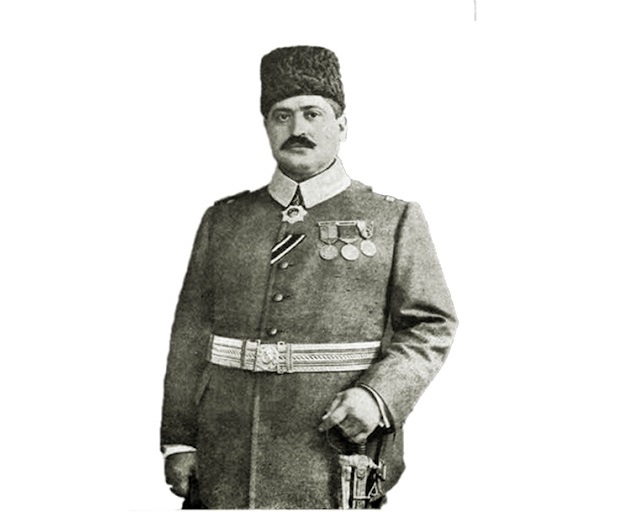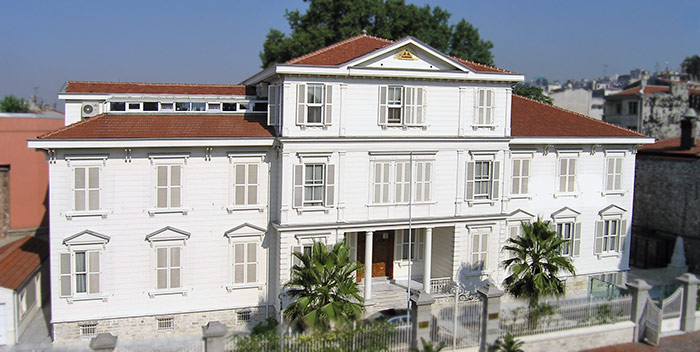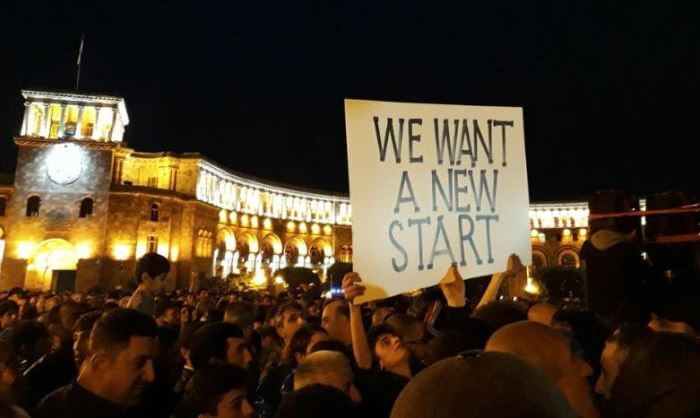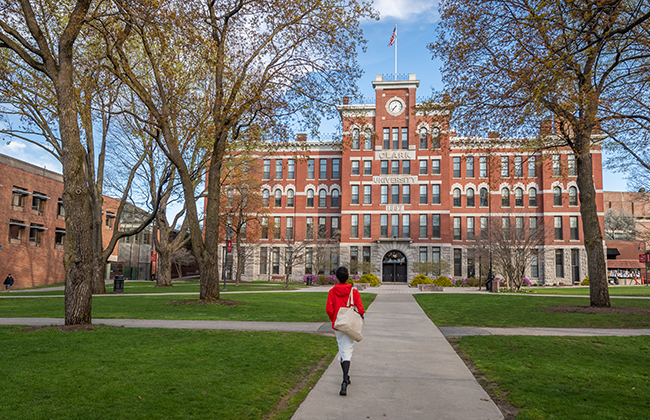
The day of 24 April, the anniversary of the events relating to the First World War of 1914-1918 and the following War of Liberation of Türkiye, has yet again led to one-sided statements of condemnation from Western countries (in particular from EU member states, the US, and Canada). Such condemnations are frequently accompanied by the wildly exaggerated figure of “1.5 million” or “over 1.5 million” Armenian losses during the above-mentioned tragic events. While the accusations directed against Türkiye and the Turks have by now become utter clichés, the remarkable point in all these is that, more than a century on, not one Western leader has expressed sorrow or any form of condemnation for the murder and death of Turks and Muslims in the same region within the same period.
During the First World War, Armenian guerilla units, operating in the rear of the Ottoman army, established contact with and offered their help to the Entente Powers. They naively believed that offering their contribution to the Entente cause would result in Armenians being rewarded with independence after the war in a region where Armenians constituted less than 20 percent of the total population. To that end, war offered the opportunity to kill and cleanse the Muslim population and change the demographic composition of Eastern Anatolia in favor of the Armenian population.
Even before the Ottoman entry into the war, the Entente Powers, in particular Tsarist Russia, began to arm the Ottoman Armenians and this only intensified after the formal Ottoman entry into the war in late October 1914.
The British warships in the Eastern Mediterranean, for example, landed men in the regions between Hatay and Adana, destroying roads, bridges, and communication infrastructures in cooperation with the local Armenian partisans, even taking some of these partisans on board their ship after the operations. The British considered a landing operation in this region, establishing contact with the rebel Armenians, as an alternative to the landing operations in the Gallipoli. In Eastern Anatolia, many Armenian men in the Ottoman army deserted their units with their weapons and joined the invading Russians against their country, while Armenian bands operating inside the Ottoman Empire cut telegraph lines and attacked the army’s logistical convoys.
Even more frustrating for the Ottomans were the events that accompanied the Russian army’s invasion of Eastern Anatolia from November 1914 onwards. During their invasion, the Russians and Armenian bands, joined in by the local Armenian partisans, committed large-scale massacres against the Muslim population, causing massive loss of life and waves of refugees fleeing into the interior for their lives. These atrocities, which began before the Ottoman government took any measures against the Ottoman Armenians, had been carried out with the aim of transforming Eastern Anatolia into a region with an Armenian majority.
As the Russian invasion expanded, the number of Muslims subjected to murder and expulsion expanded too. By the summer of 1916, the Russians were in effective occupation of much of Eastern Anatolia, including Bayezıt, Van, Muş, Bitlis, Erzurum, Erzincan, and Trabzon. While the Russians in some instances tried to limit the Armenian violence against the Muslims, the fact remains that during this time very large number of Muslims were killed and expelled from Eastern Anatolia. In addition, large waves of Muslims refugees, numbering more than a million, fled to the areas still under the Ottoman control to find safety for their lives. Major Noel, a British officer who toured the region for months and witnessed “the area occupied and devastated” by the Russian army and the Armenian and Assyrian bands that accompanied, concluded that:
“I have no hesitation in saying that the Turks would be able to make out as good a case against their enemies as that presented against the Turks... According to almost universal testimony of local inhabitants and eye-witnesses, Russians acting on the instigation and advice of Nestorians and Armenians who accompanied them... murdered and butchered indiscriminately any Moslem member of the civil population who fell into their hands. A typical example that might be quoted is the extermination of the town of Rowanduz and the wholesale massacre of its inhabitants... A traveller through the Rowanduz and Neri districts would find widespread wholesale evidence of outrages committed by Christians on Moslems.”
Similarly, Lieutenant Colonel Tverdokhlebof, a Russian officer with the Russian army of occupation in Eastern Anatolia, wrote in his diary the following entry:
“The Armenian mobs retreating from Erzincan to Erzurum exterminated all the Muslim villagers they met on their way… Those massacres were carried out in the most repulsive manner… All of those who could not manage to flee from Ilıca were massacred. The Army Commander [General Odichelitzé] said he saw lots of corpses belonging to children whose throats were butchered with blunt knives, and bodies cut into thin and long strips.”
Similarly, a fact-finding mission by two American observers, Captain Emory Niles and Arthur Sutherland, toured Eastern Anatolia extensively, observing and documenting the destruction of Muslim population and their villages, dwellings and properties. In city of Bitlis, with a population of 30,000 Muslims before the war, there were now only 4000. Of the 6500 Muslim houses in the city, none survived the war. But of the 1500 Armenian houses, 1000 were still standing at the end of the war. In the province of Van, from a population of more than 300,000 Muslims before the war, only 150,000 were in the province by 1919 and most of these people were refugees that returned to Van after the Russian retreat. Of the 3400 Muslim houses in the city of Van, merely 3 were left standing by 1919. Similar statistics were also recorded in Erzurum, Erzincan, Muş, and Bayezıt.
So thorough was the murder and cleansing of the Muslims in Eastern Anatolia that in January 1918, the German-Armenian Society, under the leadership of ubiquitous Armenophile Johannes Lepsius, had the temerity to write the following passages to the Reich Chancellor Graf Georg von Hertling:
“Armenian desires compromise attaining internal autonomy and self-rule in the 6 Armenian [Eastern Anatolian] Provinces … As mentioned before, these Provinces are now almost completely cleansed of the Muslims; the Armenians … now constitute the majority in these areas, where there was previously no majority. Therefore, the question of autonomy is now far easier to resolve then before.”
According to archival records, during this period, more than 520,000 Muslims were killed in Eastern Anatolia, in addition to more than one million refugees to other parts of the Ottoman Empire.
It was precisely in order to prevent such a scenario from taking even greater proportions that the Ottoman government felt compelled to relocate the Armenian population from the war zone in Eastern Anatolia with the temporary law of relocation and resettlement in May 1915.
The Events of 1915 took place at a time when the Ottomans were being invaded by the Russians (supported by many Armenian partisans) in the east and were being invaded by the British in Iraq in the south, while the capital city of Istanbul was being threatened by the operations in the Gallipoli in the west.
While many Muslims lost their lives in these events, many Armenians became victims of corresponding attacks from the Muslims as well. Attacks and counterattacks between Muslims and Armenians continued in a manner of ebb and flow until 1920. The Tsarist Russian advance that started in November 1914 stopped with the admission of defeat and withdrawal from the First World War with the signing of the Brest-Litovsk Surrender in early 1918, whereby Russia ceded back the territory occupied in Eastern Anatolia. Hence, the Ottoman army recuperated its losses, fighting the occupying Armenian forces. As the Ottomans admitted defeated in the First World War in late 1918, with the signing of the Mudros Armistice, their army was disbanded and Armenian forces were given a free hand again by the Entente Powers to occupy those areas, from which they had retreated earlier.
Then started the War of Liberation of the newly established Turkish National Assembly government, whose army, as a priority operation, recovered the re-occupied eastern Anatolian territory from the Armenian forces, thereby reaching the present-day boundaries of the Republic of Türkiye. These ebbs and flows unfortunately greatly added to the number of dead on both sides again, but definitely nowhere near the propagated number of Armenian losses.
Beginning with the Entente war-time propaganda in 1915, in the Western countries the suffering of Armenians was taken out of its proper historical context and presented as a singular tragedy, the only one deserving condemnation and remembrance. The fate of Turks and other Muslims were simply ignored and passed over in silence. Contemporary Western politicians and spokespersons speaking on the events of the First World War either make distorted and biased remarks on behalf of fellow Christian Armenians or otherwise maintain their callous silence on the Turks and Muslims.
This shameful double standard in recognizing human suffering must be strongly condemned in the name of historical truth, as well as to honor the memory of the victims and their descendants.
© 2009-2025 Center for Eurasian Studies (AVİM) All Rights Reserved
No comments yet.
-
 BOOK REVIEW: FROM THE LOST CITY TO THE SPIRITUAL HOMELAND
BOOK REVIEW: FROM THE LOST CITY TO THE SPIRITUAL HOMELAND
AVİM 29.06.2018 -
 HARVARD UNIVERSITY’S BELFER CENTER-UNBECOMING ACADEMICS
HARVARD UNIVERSITY’S BELFER CENTER-UNBECOMING ACADEMICS
AVİM 03.12.2019 -
 RENEWED EFFORTS TO MANIPULATE PUBLIC AND SCHOLARLY DISCOURSES ON THE ARMENIAN QUESTION BY FINANCIAL MEANS
RENEWED EFFORTS TO MANIPULATE PUBLIC AND SCHOLARLY DISCOURSES ON THE ARMENIAN QUESTION BY FINANCIAL MEANS
AVİM 08.03.2021 -
 DR. PAT WALSH’S RECENT ARTICLE ON THE TALAT PASHA QUESTION
DR. PAT WALSH’S RECENT ARTICLE ON THE TALAT PASHA QUESTION
AVİM 22.07.2020 -
 THE ELECTION OF THE ARMENIAN PATRIARCH OF ISTANBUL
THE ELECTION OF THE ARMENIAN PATRIARCH OF ISTANBUL
AVİM 22.12.2017
-
 A “REVOLUTION” “CONVENIENT” FOR ALL. NAGORNO KARABAKH CONFLICT CONTINUES TO REMAIN UNSETTLED
A “REVOLUTION” “CONVENIENT” FOR ALL. NAGORNO KARABAKH CONFLICT CONTINUES TO REMAIN UNSETTLED
Nigar SHİRALİZADE 13.06.2018 -
THE NEW “GENOCIDE” RESOLUTION PRESENTED TO THE US CONGRESS
Ömer Engin LÜTEM 24.05.2013 -
 A CONTROVERSIAL AND EMBARRASSING ACADEMIC APPOINTMENT BY AN AMERICAN UNIVERSITY
A CONTROVERSIAL AND EMBARRASSING ACADEMIC APPOINTMENT BY AN AMERICAN UNIVERSITY
AVİM 13.04.2023 -
 THE ECO AND THE CHAIRMANSHIP OF TURKEY
THE ECO AND THE CHAIRMANSHIP OF TURKEY
Selim SEÇKİN 15.11.2019 -
 US PRESIDENT TRUMP’S STATEMENT
US PRESIDENT TRUMP’S STATEMENT
Aslan Yavuz ŞİR 26.04.2017
-
25.01.2016
THE ARMENIAN QUESTION - BASIC KNOWLEDGE AND DOCUMENTATION -
12.06.2024
THE TRUTH WILL OUT -
27.03.2023
RADİKAL ERMENİ UNSURLARCA GERÇEKLEŞTİRİLEN MEZALİMLER VE VANDALİZM -
17.03.2023
PATRIOTISM PERVERTED -
23.02.2023
MEN ARE LIKE THAT -
03.02.2023
BAKÜ-TİFLİS-CEYHAN BORU HATTININ YAŞANAN TARİHİ -
16.12.2022
INTERNATIONAL SCHOLARS ON THE EVENTS OF 1915 -
07.12.2022
FAKE PHOTOS AND THE ARMENIAN PROPAGANDA -
07.12.2022
ERMENİ PROPAGANDASI VE SAHTE RESİMLER -
01.01.2022
A Letter From Japan - Strategically Mum: The Silence of the Armenians -
01.01.2022
Japonya'dan Bir Mektup - Stratejik Suskunluk: Ermenilerin Sessizliği -
03.06.2020
Anastas Mikoyan: Confessions of an Armenian Bolshevik -
08.04.2020
Sovyet Sonrası Ukrayna’da Devlet, Toplum ve Siyaset - Değişen Dinamikler, Dönüşen Kimlikler -
12.06.2018
Ermeni Sorunuyla İlgili İngiliz Belgeleri (1912-1923) - British Documents on Armenian Question (1912-1923) -
02.12.2016
Turkish-Russian Academics: A Historical Study on the Caucasus -
01.07.2016
Gürcistan'daki Müslüman Topluluklar: Azınlık Hakları, Kimlik, Siyaset -
10.03.2016
Armenian Diaspora: Diaspora, State and the Imagination of the Republic of Armenia -
24.01.2016
ERMENİ SORUNU - TEMEL BİLGİ VE BELGELER (2. BASKI)
-
AVİM Conference Hall 24.01.2023
CONFERENCE TITLED “HUNGARY’S PERSPECTIVES ON THE TURKIC WORLD"









